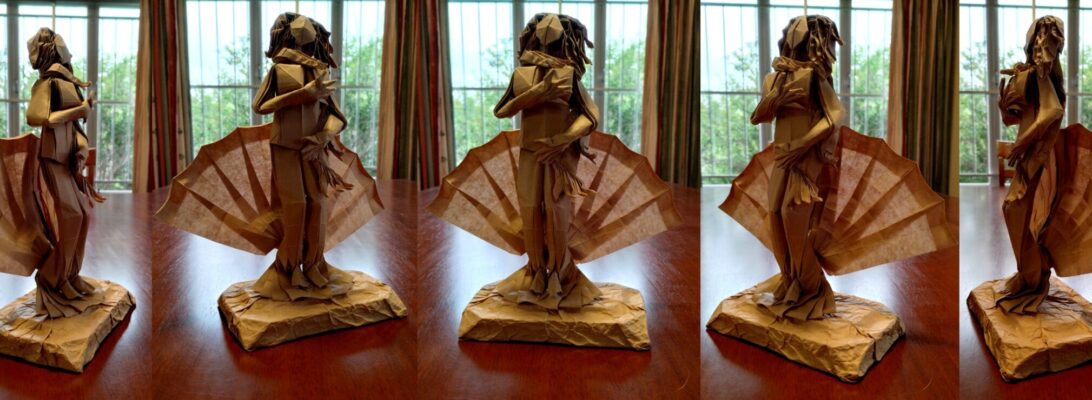When I first read Frank Herbert’s “Dune” series of books, it was the mid 70’s and I was a teenager. The expansive universe captured my imagination like little else.
Dune Part 2 has just been released in cinemas, and the Denis Villeneuve adaptation is visually stunning. On planet Arrakis (Dune), a chosen method of air travel is the “Ornithopter”, described as an insect-like flapping machine.

’Thopters in the current movie series are astonishing, if illogical from an engineering perspective. Variously, ‘Thopters have 2 to 12 wings, each move independently in a coordinated buzz to provide controlled lift and thrust.
The origami world has a few simple ‘thopter designs, most modelled on the 80’s David Lynch film adaptation, so I thought I would have a go at designing one from scratch. Initially I thought to harness an existing base, but decided I wanted 12 wings, in groups of 3, and wanted landing gear, some paper for a fuselage and various flaps for some simple detailing.

There are many design methodologies I could have employed. Circle packing (each circle centre representing the vertex of a stickey outer bit), 22.5 folding to facilitate the point-splitting needed for so many separate flaps, but settled on box pleating.

First I sketched out a rough crease pattern (CP). 12 points along opposite edges of a square. The downside of this arrangement was the points ended up tiny – way too small for the wings. Rearranging them symmetrically allowed me to include extra flaps for landing gear, cockpit and more. Designing the collapse along a 2 unit strip of the central axis also gave me the bulk for the fuselage. I calculated I could achieve this with a 48 grid.

Taking a square of thin, crispy Kraft paper, I laid in the grid, strategic diagonals and then began collapsing each of the points once I had established the pleated central axis. I had to rearrange the internal gusset to ensure the fuselage could double back on itself and, by some miracle I had a base.

Shaping the base showed me that Kraft was not a good choice for the fold, the thickness was an impedance, and would probably use Unryushi tissue should I attempt this again, it would help with the ethereal quality of the wings also.
Brute force was needed to shape the fuselage, hinge the wings and rearrange the location of landing gear – no cuts, just some tough folding through dozens of layers. The cockpit canopy naturally evolved and I went for a (clumsy) rendition of the rear loading ramp in the down position.

It was a really interesting exercise, and was so gratifying to think that I could envisage a new base that suited a specific design. In retrospect I should have made less wings (prolly 8, in 4 ranks of 2), but the light insect-like aesthetic is hinted at here.

The mechanics of a ‘thopter make it an unlikely machine. The dance of individually articulated flapping blades seems to involve a mind-boggling array of coordination and moving parts that make it completely unsuitable to such a sandy place – sand being the mortal enemy of precision engineering. The movie rendered the ‘Thopters beautifully, but we failed to see much of the interiors, which seemed cramped and oddly angular – a product of the the “dragonfly” design aesthetic.

You never really know until you fuck around and find out. I may iterate this design, we shall see. Interesting nonetheless.

